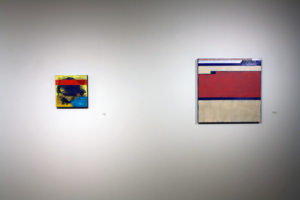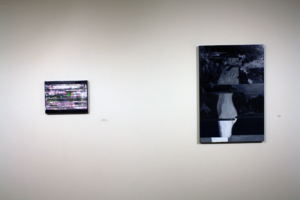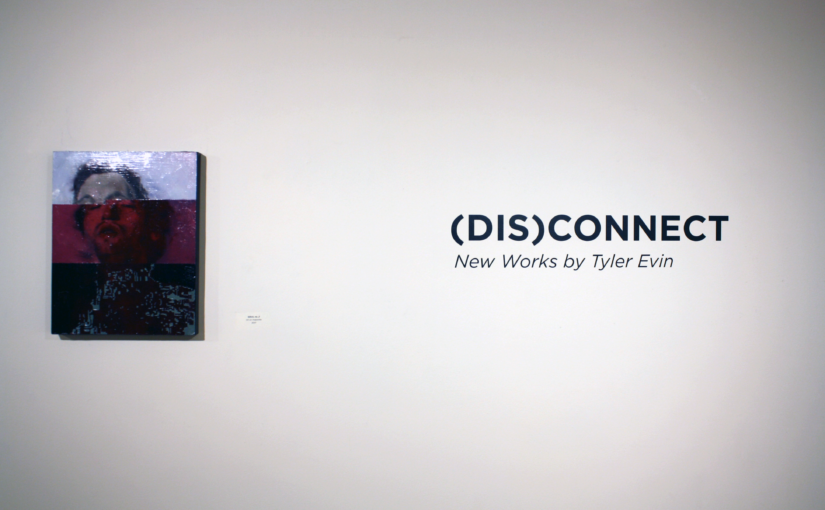
In his exhibit ‘(Dis)Connect,’ Tyler Evin’s paintings depict glitches and static, like ‘Glitch, no. 2’ (above).
Before the world of smart phones, smart TVs and smart everything, there was dial-up, static and TV test patterns that took over the screen in blotches of vibrant colors.
In his exhibit at the Memorial Union Gallery, artist Tyler Evin’s paintings depicting static, color tests and glitched portraits pull inspiration from our digital world. Entitled “(Dis)Connect,” Evin’s work is part of a larger discussion on whether or not technology and social networking actually brings us closer together, or just creates greater divides.
“(It’s) almost kind of a metaphor for how technology has affected humans and how we’ve become – well, we’re connected with each other more than ever, but we’re also very much disconnected in the same sense,” Evin explained. “Because it’s much easier to just go on the phone and shoot a text to somebody, or do things that way. It’s much less common to have a face to face thing. Interactions like that. That’s the basis for my series that I’m working on. Just how technology is affecting the genuine human connection that is kind of lost with technology and social media.”
Evin said his “visual spark” came from the glitches and static that affected his TV before the rabbit ears were adjusted. To translate that digital imagery onto canvas, Evin collaborated with photographers for reference photos. He also used Photoshop and other design tools to experiment with the physical form, something he’s comfortable with.
“I’m primarily a figurative artist. That’s what I find the most inspiration in,” he said. For this exhibit, Evin abstracted his work, adding glitches to break up the natural human form.
“(This exhibit) was a different take on portraiture and the human figure and stuff like that,” he said. “I’ve always been drawn to more abstracted themes when it comes to portraiture and figurative art. Sort of nontraditional is what I’m drawn to, nontraditional portraiture, nontraditional subject matter. It was a nice segue into that with the glitches and stuff. It’s deconstructing the forms and deconstructing the features. It’s much less about the portrait and more about the painting as a whole. I’m really enjoying where it’s taken me in my work, too. I’m always thinking about how I can constantly push the abstraction without completely losing it all.”

Evin’s original focus was on portraiture, but with his latest exhibit Evin pushed the boundaries of the human form, like in ‘Glitch study’ (left) and took a more abstract, colorful approach to painting like in ‘Technicolor, no. 1’ (right).
It’s hard to believe Evin’s paintings aren’t actually glitches, or static, or even color tests. The intricate details in each painting create the illusion that what you’re seeing has been altered by something digital.
In these works, Evin not only pushed the physical form until it resembled something broken, but he also pushed his own boundaries by adding plenty of color. Greens, blues, purples and reds, in addition to the grays and blacks, add some pop to the paintings.
“My series that I kind of started out with, when I was first developing my craft of painting, was much more monochromatic,” he said, “and obviously with this series, I’m definitely pushing my sense of color and stuff like that.”
When I first witnessed Evin’s works, I thought it was ironic how he depicted the digital world in a traditional, analog medium. However, Evin never saw it that way, saying, “I’ve always been very traditional when it comes to art. Personally, I have rarely worked in digital form. I’m always drawn to just the traditional style and old way of painting. I guess it is kind of ironic now that I stop and think about it. The thought doesn’t really cross my mind when I started or when I kind of got going on it. It just seemed normal to me, I guess.”
The overall exhibit, said Evin, isn’t meant to make a viewer feel either positively or negatively about technology. He just hopes that the paintings prompt the viewer to think deeply about technology, how it affects them and how it affects the world around them.
“I really like to keep my work very open-ended,” he explained. “I don’t ever like to tell people how I want them to look at my work because I feel like everybody deserves their opinion and everybody can interpret my work as such. They can view it how they want. That’s why I really do like to keep things as subjective as I can so I don’t really try to sway the viewer in any certain direction. But I guess I’ll just say that from what I’ve noticed, with technology it’s taken us in directions that I don’t think anybody could have predicted, but sometimes we lose things along the way, I guess.”
He continues, saying, “I love hearing people’s opinions and what they interpret the piece as. I think that’s the beauty of art, people can see one thing and then another person can see a completely other thing. Who am I to tell you how to look at something, or how to interpret a piece? I think that is something that I love about creating is just the mass, the wide range of interpretations that people can have with your work.”
While the paintings might lend themselves to students on campus, whose world has been shaped by technological advancements, Evin wasn’t targeting any specific age, demographic or person – rather, he was more interested in creating a conversation.
“I hope that a viewer can leave thinking about how in this world of technology,” explained Evin, “and the advancements and stuff like that, how they interpret, how it affects them personally. How they’ve seen it affect their lives. It’s all I hope for, is that they stop and think about maybe what technology has done for them or what it has affected them negatively or positively.”

The static on his TV screen became a visual spark for Evin, ultimately influencing his decision to paint it, like in ‘Static, no. 2,’ (left). He also was fascinated with warping the human form, like in ‘Glitch, no. 4’ (right).
Evin wants to continue with the series, taking it farther into the world of abstraction.
“I’m not planning any change in direction as far as where this is taking me,” he said. “I think I’m only going to push it further like I kind of talked about. Pushing the portrait and the figure into oblivion with sort of that glitched realm.”
His process is that there is no process – just an idea in his head that he tries to relate onto the canvas, but that quickly changes depending on the painting.
“I kind of have an idea in my head before I start any painting, but it kind of takes a life of its own,” explained Evin. “What I think I want in the beginning rarely ends up what comes out in the end. For example, one of the figurative pieces, I would probably find my inspiration through the reference that I’m using and then, and then that kind of leads to changing it and editing and messing it up a bit and then it leads to what colors, what mood I’m trying to portray which is all kind of fluid at that point still. It’s not until I start getting into it that I’m realizing what it needs or what kind of mood I’m going for.”
Evin’s works will be on display at the Memorial Union Gallery until Sept. 28, with a reception tomorrow, Sept. 19, at 5 p.m. Evin will be speaking about his works that evening, at 5:30 p.m.
To view more of Evin’s works, visit his website at www.tylerevin.com.
